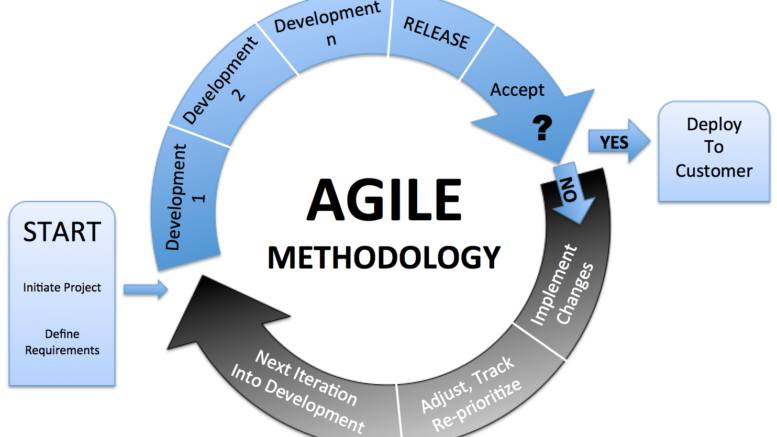Agile Software Development
, also widely known as Agile, is a software development methodology that provides high flexibility and efficiency. Methodology synonym It needs a cultural shift in many Methodology synonym organizations as it emphasizes the clean delivery of individual software parts and not on the whole application.
Agile methodology helps teams in evolving perspectives along with focusing on efficient business value delivery. The collaborative culture of Agile also enhances efficiency in the whole organization as teams collaborate and acknowledge their particular roles in the process.
Companies that are leveraging Agile Methodology for software development feel confident about superior-quality software products as testing is performed throughout the development. It serves the possibility to perform changes as required and alert the development team in advance about any potential risks.
Stages of Agile Life Cycle
The Agile SDLC is a structured series of different phases that a software product must follow. It includes six stages. Let’s consider each one of them.
1. Concept
The first stage of SDLC includes outlining visuals and outcomes and imagining business through developing an app.
Businesses define the estimated development time frame, necessary resources, opportunities, and workforce, and validate project usefulness. Based on this detail, you can evaluate technical and economic feasibility. This stage is all about deciding the pathway of the SDLC.
It is required at the beginning to clearly define the methodology project goals. It creates the guidelines to follow when the project gets developed according to business demands.
Key takeaway: In the Concept stage, project owners decide on the project scope, and prioritize needs, features, functionalities, and customers’ demands.
2. Inception
It is considered a planning phase for the whole project. In this stage, team members are determined, funding gets confirmed, and the preliminary requirements are discussed with the client.
A sprint is a set of time frames in which a particular task has to be concluded and ready for review.
This phase helps in getting a sound knowledge of team flexibility and how the finished product looks.
Key takeaway: The team is built in the Inception stage and begins with the software structure planning.
3. Iteration/Construction
In this phase, development teams begin with building a working software methodology according to client demands and constant feedback.
The Agile SDLC depends on various iterations. Each iteration lasts for two/or four weeks. The key objective is to have an operative software to launch at the end of every iteration.
Many iterations occur through the software SDLC with its own workflow. An ordinary iteration flow comprises,
- Defining requirements according to product and sprint backlog and customer and stakeholder feedback.
- Software development according to defined needs.
- Performing QA testing, internal/external training, and documentation.
- Providing and incorporating the working product into production
- Collecting stakeholder and customer feedback for each iteration to define new requirements for the upcoming sprint.
Key takeaway: Iteration is the longest stage of Agile SDLC as its emphasis is on the teams that deliver a superior quality software system via incremental sprints.
4. Release
You are now almost ready to release your software product in the real market. You have to conclude this ongoing software iteration by following below mentioned steps.
- Testing the software – A QA (Quality Assurance) team needs to perform different types of testing such as Unit Testing, Integration Testing, Acceptance Testing, and System Testing on the software’s features and functionalities, find bugs and keep a record of achievements and losses.
- Address defects – Teams need to make an effort towards resolving the bugs defected in the software system.
- Finalization of software and user documentation – Visualizing code through Unified Modelling Language (UML) diagram or display user flows that aid all to acknowledge the functioning of the software and what they can develop upon it.
- Release an iteration into production.
Key takeaway: QA testing was performed in the Release stage. It is the last stage before delivering a product in the actual market.
5. Production and Maintenance
This stage includes ongoing support and maintenance for the software system release. The team should keep the software running flawlessly and demonstrate to users how to utilize it.
The production stage keeps going until the support and maintenance have been completed or are planned for retirement.
Key takeaway: The software product becomes available for the customers. Teams provide ongoing support and maintenance services for the developed software.
6. Retirement
This is the last stage of the Agile software development life cycle that incorporates all end-of-life tasks like informing customers and final migration. The latest software is released, and the older version is not supported anymore.
The software methodology might experience minor updates and modifications. But, this software system would get released from the production cycle when they are no more budget-friendly or benefit the specified goals.
Key takeaway: Teams thoroughly assess their overall performance and determine strengths and weaknesses across the project.
Advantages of Agile Software Development Life Cycle
- The project gets divided into smaller transparent iterations/sprints.
- It mitigates software development risks.
- It consists of a flexible change process.
- The functional requirements are applied in the development process.
- It helps with a quick release of the first version of a software system.
- Customers can test the outcome and identify if it is up to the mark or not.
- High-priority needs are focused on first.
Drawbacks of Agile Software Development Life Cycle
- It needs a highly professional and user-centric development team.
- There are high canes of projects that will cross the expected time frame as additional changes and corrections take place.
- New requirements may be incompatible with the existing structure.
- You can not clearly estimate the final project cost as iteration is constant in Agile development.
- There is nothing like defined requirements.
Summing Up
Agile Software Development Life Cycle is an excellent choice if you are keen to develop large-sized, enterprise-level projects with a pretty complicated and fuzzy set of requirements.
There is not a stiff Agile architecture that guarantees project success. However, one thing is inevitable deploying a successful software product is impossible without a skilled and professional development team. So search for the superior team to leverage the best of Agile SDLC.








10 Comments